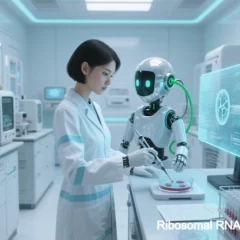CRISPR (Clustered Regularly Interspaced Short Palindromic Repeats) is a revolutionary gene-editing technology derived from a natural bacterial immune system.
Key points:
Uses a guide RNA to direct the Cas9 protein to cut specific DNA sequences.
Allows precise insertion, deletion, or modification of genes.
Applications: curing genetic diseases, improving crops, biomedical research.
Nobel Prize in Chemistry (2020) awarded to Doudna & Charpentier for its discovery.
It’s faster, cheaper, and more accurate than older gene-editing methods.

Ribosomal RNA
Ribosomal RNA (rRNA): Multidimensional Insights Revolutionizing Life Sciences From Reconstructing the Tree of Life to Precision Medicine I. Evolution and Taxonomy: Rewriting the Foundations of Life The Three-Domain System: Comparative analysis of 16S/18S rRNA sequences revealed the Bacteria, Archaea…

Transfer RNA
tRNA (Transfer RNA) in Developing Novel Therapeutics: Targeting Bacterial tRNA for Antibiotic Innovation A Strategic Breakthrough Against Bacterial Core Life Processes and Drug Resistance I. The Central Role of tRNA in Bacterial Survival and Targeting Advantages tRNA is pivotal in protein synthesis,…

Messenger Ribonucleic Acid
Gene Therapy and Protein Replacement Therapies: Recent Advances in Restoring Abnormal Gene Function (as of May 2025) I. Gene Therapy: From Single-Gene Repair to Cancer Immunotherapy Revolution Gene therapy corrects or compensates for defective genes through strategies such as gene editing, gene augm…

synbioh.com
Synthetic Biology Hybrid (SynBioH): Designing Hybrid Biological Components and Chimeric Metabolic Pathways Engineering Enhanced Biosystems Through Cross-Species Integration and Pathway Innovation Core Principles and Design Strategies SynBioH combines elements from diverse biological systems or redes…

synbiof.com
Synthetic Biology (SynBio): Engineering Biosystems for Medicine, Energy, and Materials Synthetic biology (SynBio) is a revolutionary discipline that merges engineering principles with biological systems to design, construct, and optimize novel organisms or biological components. By reprogramming gen…

synbioml.com
Syn BioML: Convergence of Synthetic Biology and Machine Learning Algorithm-Driven Innovations in Drug Development, Disease Diagnosis, and Biomanufacturing Technical Framework and Core Principles Syn BioML (Synthetic Biology Machine Learning) integrates synthetic biology with machine learning to deco…

synthmrna.com
Synth mRNA (Synthetic mRNA): Innovations in Cancer Immunotherapy and Rare Disease Treatment From Tumor Neoantigen Delivery to Defective Protein Repair Cancer Immunotherapy: Precision Delivery of Tumor Neoantigens and Immune Activation 1. Core Technologies for Neoantigen Vaccines AI-Driven Antigen Sc…

SynthVaccine.com
Synth Vaccine (Synthetic Vaccine): Advances in Viral and Cancer Vaccine Development From Precision Antigen Design to Industrial-Scale Innovation Viral Vaccines: Synthetic Biology-Driven Rapid Response and Broad Protection 1. mRNA Technology Advancements Antigen Optimization: Structural Biology-Guide…

haptisense.com
Hapti Sense: Innovations in Haptic Feedback and Sensory Enhancement Technologies 2025 Technological Landscape and Future Perspectives Core Technological Breakthroughs: From Mechanical Vibration to Multimodal Sensory Enhancement Flexible Materials and Wearable Innovations Skin-integrated haptic inter…

synbiov.com
SynBio V: Engineering Viral Vectors for mRNA Vaccine Design and Production Integrating Viral Delivery Systems with Synthetic Biology Tools 1. Technological Foundations: Synthetic Biology Reengineering of Viral Vectors Viral vectors, as core mRNA delivery tools, require synthetic biology modification…










